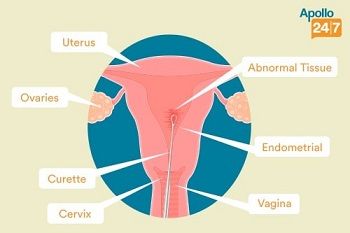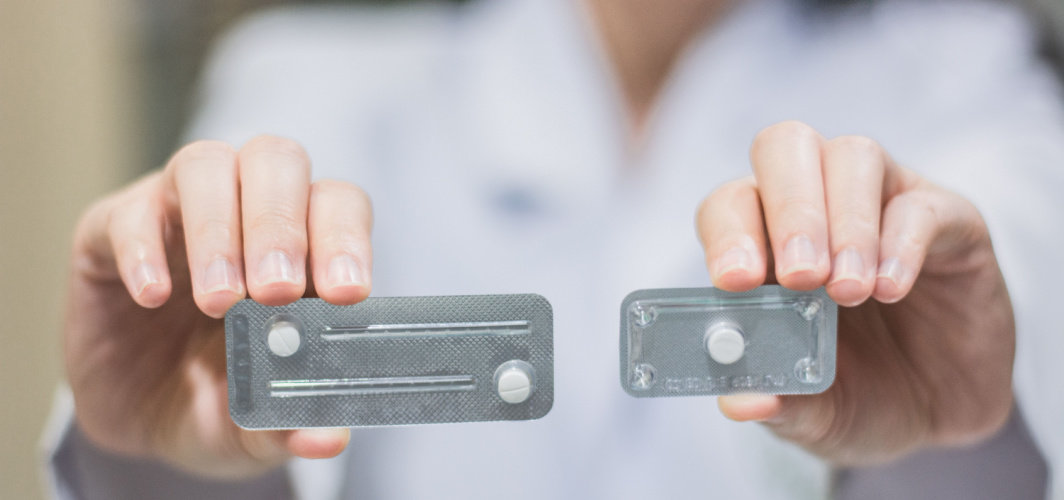- Home
- Blog
- Women Care
D and C Procedure: What is it and its Cost in India?
Women Care
D and C Procedure: What is it and its Cost in India?
By Apollo 24|7, Published on- 06 June 2022, Updated on -01 February 2023
Share this article
0
23 likes

Wondering what D and C mean? D and C is the abbreviated form of Dilation and Curettage. It is a medical procedure performed by many gynecologists or obstetricians to diagnose or treat some uterine conditions such as abnormal or heavy uterine bleeding, uterine polyps, uterine cancer, etc.
In this post, we will discuss the reasons why the d&c procedure is recommended and its cost in India. Also, we will discuss what happens during the d and c procedure.
Reasons for D and C Procedure
Gynecologists or Obstetricians can recommend the d and c procedure because of the following reasons.

- To detect the reason or the cause behind the abnormal and heavy bleeding from the uterus or between the menstrual periods.
- To diagnose and treat abnormal growths in the uterus like polyps.
- To investigate the reason for difficulty becoming pregnant.
- To detect uterus cancer [biopsy].
- To remove the uterus lining or tissues during or after a miscarriage.
- To remove the placenta [in pieces] after childbirth.
- To scrap the infected tissue in the uterus caused by a sexually transmitted disease, PID [pelvic inflammatory disease].
- To perform an elective abortion.
We have the best Gynecologists and Obstetricians all over India and you can consult them to know whether you require a d and c procedure or not.
If you are confused in making a decision, we have expert doctors with whom you can have a second opinion. Click the below button for the same.
What is Dilation and Curettage [D and C] and How is it Performed?
As said earlier, d and c is a surgical procedure performed to remove the abnormal or leftover infected tissues, polyps, etc. in the uterus. In this, the surgeon will dilate the lower part of the uterus [cervix] and remove the uterus lining by scraping and scooping.
From the below pointers you can know how d and c surgery is performed.
- Primarily, an anesthesiologist administers you with either local or general, or spinal anesthesia. This makes you fall asleep or numbs the surgical area.
- Either the nurse or a doctor monitors all the vital signs like heartbeat, oxygen levels, respiratory rate, pulse rate, etc throughout the surgery.
- Then, the surgeon inserts a speculum into the vagina for a better view of the cervix. The speculum helps in spreading the vaginal walls.
- Now, the doctor dilates the cervix using slim rods made of synthetic firm gel. Each synthetic rod differs in size from one other [dilation process]. In a few cases, medications are used to dilate the cervix.
- Once the cervix is dilated enough, the surgeon performs a hysteroscopy. In this, a small light and camera are used to check and examine the internals of the uterus for abnormal areas.
- Then, the surgeon inserts a spoon-shaped instrument [curette] into the vagina.
- Using the curette, the lining of the uterus is scraped and spooned out. In a few cases, a suction device may be used to remove the tissues or the lining.
- Once the lining or the contents of the uterus are removed, the surgeon removes the instruments from the vagina.
The surgeon sends the removed uterus contents to a laboratory for further analysis or diagnosis of the condition. In a few cases, a special forceps called a tenaculum can be used by the surgeon to hold the cervix open steady for the entire procedure.

To know more details about the d and c procedure and how this procedure is used for elective abortion or as a treatment for miscarriage, consult our Gynecologists.
Care After d&c
After undergoing the d & c procedure, you will be shifted to the recovery area where the doctor or the attending nurse will monitor your health vitals.
Once the anesthesia effect wears off, the doctor will plan to discharge you from the hospital. Before discharge, you will be asked or suggested to follow a few precautions that help you recover and heal quickly.
Some of those precautions or care tips are mentioned below.
- Don’t drive or use automobiles for a day or two.
- Ask your friend or a family member to drive you home safely.
- Take ample rest and avoid doing stressful activities.
- Wear sanitary pads for a few days as light vaginal bleeding is normal after undergoing the d & c procedure.
- Don’t douche [cleaning inside of the vagina] and follow all the instructions suggested by the doctor.
- Avoid having intercourse for a day or two.
- Don’t lift heavy weights until your doctor says so.
- Follow the dietary restrictions if your doctor says so.
- Take painkillers and other certain medications as prescribed by the doctor for cramping and soreness.
- Do not skip your follow-up appointments. They help your doctor to evaluate and understand how well the d & c procedure is affecting your overall health.
Consult your doctor in case you have heavy bleeding, fever/chills, unbearable abdominal pain, and foul-smelling drainage from the vagina.
D and C cost in India
After knowing what exactly d & c is, and how and why it is performed, you may be wanting to know its cost in India.
- Minimum D and C procedure cost in India can start from Rs. 5,000
- Average D and C procedure price in India can be Rs. 15,850
- Maximum D and C procedure cost in India can rise up to Rs. 25,500
This price range for the d&c procedure keeps changing from one city to another in India. To help you with the same, we mentioned the minimum, average, and maximum cost of the d & c across multiple cities in India. Please do refer to the below table.
|
Name of the City |
Minimum d&c Cost |
Average d&c Cost |
Maximum d&c Cost |
|
Delhi |
Rs. 6,500 |
Rs. 15,850 |
Rs. 25,500 |
|
Gurgaon |
Rs. 6,000 |
Rs. 15,000 |
Rs. 24,500 |
|
Noida |
Rs. 6,000 |
Rs. 15,000 |
Rs. 24,000 |
|
Hyderabad |
Rs. 6,500 |
Rs. 15,500 |
Rs. 24,850 |
|
Chennai |
Rs. 6,000 |
Rs. 14,855 |
Rs. 24,500 |
|
Bangalore |
Rs. 6, 250 |
Rs. 15,750 |
Rs. 25,000 |
|
Pune |
Rs. 5,000 |
Rs. 14,950 |
Rs. 23,650 |
|
Mumbai |
Rs. 7,000 |
Rs. 15,850 |
Rs. 25,500 |
|
Faridabad |
Rs. 5,500 |
Rs. 15,000 |
Rs. 24,000 |
|
Kolkata |
Rs. 5,850 |
Rs. 15,250 |
Rs. 24,850 |
|
Chandigarh |
Rs. 5,000 |
Rs.14,950 |
Rs. 24,550 |
|
Gujrat |
Rs. 5,000 |
Rs. 14,680 |
Rs. 24,750 |
Note: Use the cost mentioned in this article for reference purposes only. It doesn’t depict the exact cost of the D and C procedure in various cities of India. Know the exact cost of the d&c procedure by contacting the specific hospital from where you wish to undergo the surgery.
Frequently Asked Questions [FAQs] About the D&C Procedure
1. How long does it take to perform the d&c procedure?
Usually, the surgeon may take around 20 to 45 minutes to complete the d & c procedure. This time duration may vary depending on multiple factors such as the severity of the uterine problem, the overall health condition of the patient, and the experience of the surgeon.
2. Is the d and c procedure painful?
No. The d and c procedure is not painful because the patient will be given anesthesia that helps to either numb the surgical area or makes the patient fall asleep.
3. How many days of rest do I need after d&c?
After undergoing the d&c procedure, most of the patients are advised to take rest for at least 2-5 days. Also, gynecologists do recommend their patients follow all the necessary care tips or precautions to heal and recover quickly after the surgery.
4. Will I have heavy bleeding after d and c?
Yes. You may have light bleeding after the d and c procedure. However, the bleeding stops after a few days. In case there is severe vaginal pain with abnormal or heavy bleeding
5. Can d&c abortion affect my future pregnancy?
The d&c abortion doesn’t affect your ability to get pregnant and your future pregnancy. It also does not increase the risks of pregnancy complications.
6. What are the side effects of d and c?
There are no major side effects associated with the d&c procedure. Some of the common side-effects that can occur rarely are:
- Pelvic cramping
- Light vaginal bleeding
- Vaginal pain
- Discomfort
For further details about the D and C procedure, you can consult our expert doctors by clicking the below button.
Medically Reviewed by Dr. Dhanunjay Reddy B
Services
Women Care
Leave Comment
Services
Recommended for you

Women Care
Tips To Keep Your Hygiene High During Periods
Maintaining good hygiene during periods prevents women from infections and other health issues. From frequently changing your pads to keeping your vagina clean, here are some tips to keep hygiene high during periods.

Women Care
I-Pill: Indications, How to Use, Side-Effects
Explore I-Pill's indications, usage guidelines, and potential side effects. Make informed choices about this contraceptive option.

Women Care
Menopause and Osteoporosis: When to Start Worrying About Your Bones?
Oestrogen, an important hormone that strengthens the bone mass, drops substantially around menopause. Thereby, dropping an average woman's bone mass by up to 10% in the first five years after menopause. Read more to know how you can prevent weak and brittle bones as you reach your 50's.
Subscribe
Sign up for our free Health Library Daily Newsletter
Get doctor-approved health tips, news, and more.

